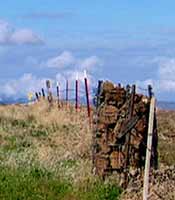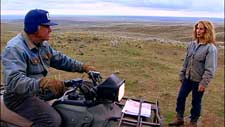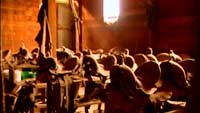I was looking forward to the road trip to the Imperial Stock Ranch, and learning more about what it takes to run a large ranch. Thoughts of open spaces, corrals, and cowboys on horseback all came to mind.
The eastern side of Mt. Hood is a beautiful part of the country, one that I continue to savor discovering. As Lynn and I came out of the Columbia Gorge, past the communities of Hood River, and The Dalles, the land began changing from the majesty of the gorge to rolling green hills to hills spattered with black and brown craggily rocks and tufts of grass. After miles and miles of this kind of landscape we came into the town of Maupin, a population of 411 people, and our new home for the next several days.
The next morning we left early, filled our coffee cups and headed further into the high desert. It was early spring, the air was cool, and the landscape contained a great expanse of rocks, dry earth and short clumps of grass.

Then we began seeing the strangest thing…vertical wired baskets full of what looked like brown lava-like rock. Some of these baskets were tall (3-4 feet), others stubby. Often they were nestled around a fence post. There were no buildings, no signs, just these rock-filled baskets and fence poles going on for miles. Who gathered these rocks? How far did they have to carry them? And when was it done?
Finally, I came to the road I was looking for, Hinton Rd, named after the man that came across the plains in a covered wagon with his family in 1852. How did R.R. Hinton ever find this place?! After yet another mile, or so, down this road, I finally came upon the homestead that was originally built by Mr. Hinton, and for the past 21 years, the current home of Dan and Jeanne Carver.

Dan Carver was about five miles away at one of the headquarters (they have four), as we began talking with Jeanne. He called down to the ranch house to let us know he was about to start herding some of his cattle from the corral to the pasture. From baseball caps to cowboy hats, several fellows were moving cattle from corral to corral, before releasing them to graze in a new area. This was a modern roundup, instead of horses, the ranch used All Terrain Vehicles (ATV’s), except in the more rugged terrain where they still used horses.
Later in the day I got to meet Bruno and Babe, the 2 Maremma sheepdogs, who guard, well, the sheep! They fit right in – big and white themselves – and are at home on the rocky landscape. The Carvers introduced them into the sheep family when they were losing up to six lambs a week, and since their arrival they have not lost any lambs to predators. These big dogs may look lovable from the outside but they spend their days and nights with the sheep, and the only humans they have regular contact with are Dan and Jeanne Carver. They consider everyone else a possible predator, and so I kept a respectful distance as I filmed their sheep ‘family’.
The second day I spent wandering the property and filming the different buildings, fields, and livestock. Many of the buildings were built by the original founder of Imperial Stock Ranch, Richard Roland Hinton. The buildings were beautiful in their simplicity and well-aged in character. The planks on the outside wall of the shearing shed undulated from one end to another. I imagine the decades in dry desert heat had this effect.

But the room that took my breath away was the old ‘museum’ room on the backside of the hay barn. The old iron latch creaked open and there before me were a dozen or so saddles in the warm red-brown glow of the wood. Two small windows, facing west, were situated high above, out of reach of the cowboy laying his saddle to rest at the end of the day. Still horseshoes, dusty reins, and brown bottles half filled (with who-knows-what) sat motionless in the dust. Dust that was probably decades old too. A room once filled with sweat from a hard days work was now a room full of memories. An era that once was, to a time that now is.
The Carvers are working hard to preserve the original buildings that serve as a symbolic link to the past, while continuing the proud tradition of ranching responding to the ever changing economic landscape, and thriving.
Most of the videos featured on Cooking Up a Story were produced, filmed, and edited by Rebecca Gerendasy. Fred Gerendasy contributed as a writer to many of the posts and occasionally as the interviewer. Visit Rebecca Gerendasy Clay – Art and Fred Gerendasy Photography to see their current work.
